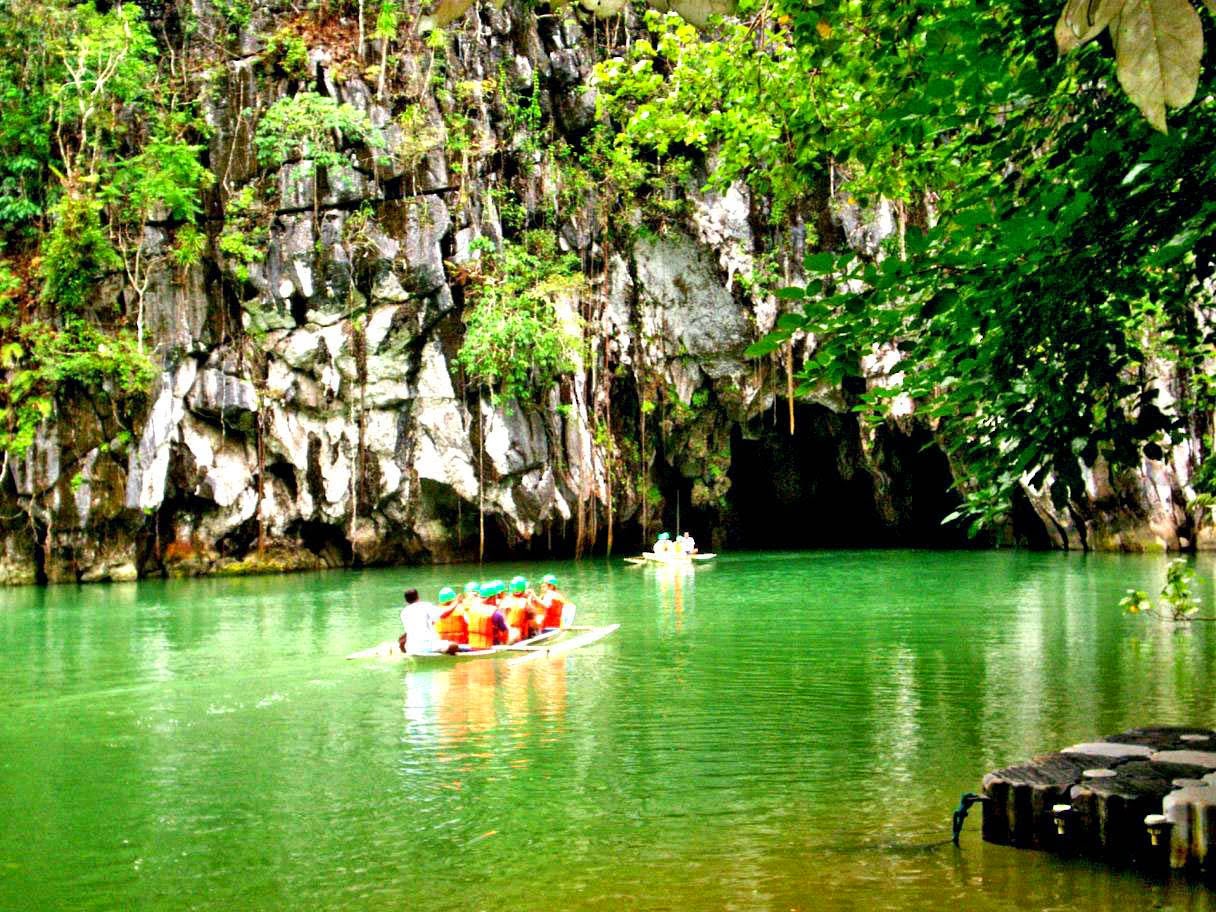The site of the Puerto-Princesa Subterranean River National Park is located in the Saint Paul Mountain Range. It is north-west of Puerto Princesa, the capital of Palawan Province. The topography varies from flat plains to rolling hinterlands and hills to mountain peaks. Over 90% of the park comprises sharp, karst limestone ridges around Mount St Paul, which is itself part of a series of rounded, limestone peaks aligned on a north-south axis, along the western coast of Palawan.
The focus of the area is a spectacular karst landscape which features both surface karst features (pinnacles, shafts, dolines and limestone cliffs), as well as an extensive underground river system. The subterranean river is 8.2 km long, one of the most unique of its type in the world and includes many speleotherms, several large chambers exist, up to 120 m wide and 60 m high. A distinguishing feature of the river is the fact that it emerges directly into the sea, and that the lower portion of the river is brackish and subject to tidal influences.
The underground river (the Cabayugan River) arises approximately 2 km south-west of Mount Saint Paul at an altitude of 100 m, and flows underground for almost its entire length to an outflow into St Paul's Bay. All rivers and associated tributaries are within the park, which is important in relation to catchments impacts on the water quality of the Cabayugan River.
Approximately two-thirds of the site is forested, dominated by hardwood species. Three forest formations are present: lowland, karst and limestone. The karst forest is restricted to small pockets where soils have developed. In the coastal area, mangroves, mossy forest, seagrass beds and coral reefs are also found.
The faunal diversity in the park is moderate, especially with respect to invertebrates. Endemic mammals include the Palawan tree shrew, Palawan porcupine and Palawan stink badger. Dugong has been recorded in the marine component of the park. Monitor lizard and marine turtles are also present. The Palawan Peacock Pheasant has also been recorded in this site (recognized as an internationally threatened species). The subterranean fauna has not been studied in detail, but comprises fish, prawns, snakes and insects. The tunnel and chambers of the subterranean river are home to abundant populations of swiftlets and bats. Eight species of bat are also found in the cave, and cave swiftlets nest on some of the underground boulder piles. Further studies are required to determine the extent and diversity of the underground fauna.
The focus of the area is a spectacular karst landscape which features both surface karst features (pinnacles, shafts, dolines and limestone cliffs), as well as an extensive underground river system. The subterranean river is 8.2 km long, one of the most unique of its type in the world and includes many speleotherms, several large chambers exist, up to 120 m wide and 60 m high. A distinguishing feature of the river is the fact that it emerges directly into the sea, and that the lower portion of the river is brackish and subject to tidal influences.
The underground river (the Cabayugan River) arises approximately 2 km south-west of Mount Saint Paul at an altitude of 100 m, and flows underground for almost its entire length to an outflow into St Paul's Bay. All rivers and associated tributaries are within the park, which is important in relation to catchments impacts on the water quality of the Cabayugan River.
Approximately two-thirds of the site is forested, dominated by hardwood species. Three forest formations are present: lowland, karst and limestone. The karst forest is restricted to small pockets where soils have developed. In the coastal area, mangroves, mossy forest, seagrass beds and coral reefs are also found.
The faunal diversity in the park is moderate, especially with respect to invertebrates. Endemic mammals include the Palawan tree shrew, Palawan porcupine and Palawan stink badger. Dugong has been recorded in the marine component of the park. Monitor lizard and marine turtles are also present. The Palawan Peacock Pheasant has also been recorded in this site (recognized as an internationally threatened species). The subterranean fauna has not been studied in detail, but comprises fish, prawns, snakes and insects. The tunnel and chambers of the subterranean river are home to abundant populations of swiftlets and bats. Eight species of bat are also found in the cave, and cave swiftlets nest on some of the underground boulder piles. Further studies are required to determine the extent and diversity of the underground fauna.













No comments:
Post a Comment